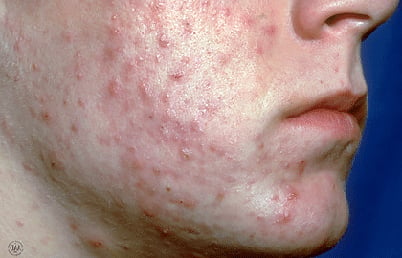Acne is a prevalent skin condition that affects millions of people, particularly during adolescence, though it can persist into adulthood. The causes of acne are multifaceted, including hormonal changes, excessive oil production, and clogged pores. However, emerging research suggests that the balance of gut bacteria plays a significant role in the development and severity of acne. Probiotics and prebiotics, which influence gut health, are emerging as potential treatments for acne. This article explores the connection between gut health and acne, and how probiotics and prebiotics may offer beneficial treatments for the skin condition.
Understanding Acne: A Complex Condition
Acne occurs when hair follicles on the skin become clogged with oil, dead skin cells, and bacteria. These blocked pores can lead to inflammation, redness, and pustules commonly seen in acne. The primary cause of acne includes hormonal fluctuations, especially androgens, which increase oil production. Other contributing factors are genetics, environmental factors, diet, and stress. In recent years, emerging research suggests that the gut-skin axis, the relationship between gut health and skin conditions, could be a key factor in acne development (Bowe & Logan, 2011).
The Gut-Skin Axis: How Gut Health Influences Skin
The gut and skin are connected through a complex system involving the immune system, hormones, and the microbiome. The gut microbiome consists of trillions of microorganisms, including bacteria, fungi, and viruses, which play a crucial role in digestion, immunity, and overall health. An imbalance in the gut microbiome, known as dysbiosis, can lead to systemic inflammation, which may affect the skin and contribute to conditions like acne (Zouboulis, 2015).
Dysbiosis can trigger an overgrowth of harmful bacteria and inflammation, which can manifest as acne. Moreover, the gut microbiome can influence the production of sebum (skin oil) and impact the skin’s barrier function, making it more susceptible to acne. Therefore, improving gut health through probiotics and prebiotics may provide a way to reduce acne symptoms and inflammation.
What Are Probiotics?
Probiotics are live beneficial bacteria that, when taken in adequate amounts, can provide health benefits. They are most commonly consumed through fermented foods like yogurt, kefir, sauerkraut, kimchi, and supplements. Probiotics help to maintain a balanced gut microbiome by promoting the growth of good bacteria and inhibiting the growth of harmful bacteria.
The most commonly studied probiotics include strains from the Lactobacillus and Bifidobacterium families. These probiotics are known for their anti-inflammatory and immune-modulating effects.
What Are Prebiotics?
Prebiotics are non-digestible fibers and compounds that feed beneficial gut bacteria, helping them thrive. Prebiotics are found in a variety of plant-based foods, including garlic, onions, bananas, asparagus, and whole grains. Unlike probiotics, which introduce live bacteria into the gut, prebiotics serve as food for the good bacteria already present in the digestive system.
When prebiotics are consumed, they help to stimulate the growth and activity of beneficial bacteria like Bifidobacterium and Lactobacillus, which can enhance the gut’s ability to combat harmful pathogens. This may help reduce inflammation in the body and improve skin conditions such as acne.
How Probiotics and Prebiotics May Treat Acne
1. Reducing Inflammation: One of the most significant benefits of probiotics and prebiotics is their ability to reduce inflammation. Since acne is an inflammatory condition, balancing the gut microbiome may help reduce the inflammatory response that contributes to acne. A study published in the Journal of the American Academy of Dermatology is found that probiotics could significantly reduce the severity of acne by decreasing inflammation (Perricone, 2010).
2. Regulating Hormones: Hormonal fluctuations, particularly the increase in androgen levels, are a major cause of acne. Research suggests that the gut microbiome may influence hormone regulation. Probiotics and prebiotics can help balance hormone levels by modulating the gut-brain axis, which affects hormonal responses. By maintaining a healthy gut, individuals may be able to manage acne flare-ups triggered by hormonal changes (Bowe & Logan, 2011).
3. Modulating Sebum Production: Excessive sebum production is another key factor in acne. Some studies suggest that probiotics may help regulate sebum production. For instance, Lactobacillus species have been shown to help regulate the skin’s oil production, thus preventing clogged pores and the subsequent development of acne (Zouboulis, 2015).
4. Strengthening the Skin’s Barrier: A healthy gut microbiome also contributes to the health of the skin barrier. When the skin barrier is compromised, it becomes more vulnerable to irritants and pathogens, which can trigger acne. Probiotics can improve the skin’s ability to retain moisture and maintain its protective barrier, making it less prone to breakouts.
5. Fighting Harmful Bacteria: Dysbiosis in the gut can lead to an overgrowth of harmful bacteria, which may contribute to acne. Probiotics help restore balance by promoting the growth of good bacteria that suppress the growth of acne-causing bacteria like Propionibacterium acnes. This balance in the gut microbiome can have a positive impact on the skin’s appearance and reduce acne outbreaks.
Research on Probiotics and Prebiotics for Acne Treatment
A 2014 study published in Beneficial Microbes found that individuals who took probiotic supplements experienced a significant reduction in acne severity. Similarly, a study in the Journal of Dermatological Treatment found that topical applications of probiotic-based treatments, as well as oral supplementation, helped reduce acne lesions and inflammation (Sung et al., 2015).
Another study in Dermatology found that prebiotics could enhance the effects of probiotics on skin health. By feeding the good bacteria and helping them thrive, prebiotics might amplify the acne-fighting benefits of probiotics (Cani, 2017).
How to Incorporate Probiotics and Prebiotics into Your Diet
1. Probiotics: To benefit from probiotics, consider consuming fermented foods such as yogurt, kefir, kimchi, sauerkraut, and miso. If you prefer supplements, look for those containing Lactobacillus and Bifidobacterium strains. Aim to incorporate probiotic-rich foods into your diet daily for optimal results.
2. Prebiotics: Eating foods rich in fiber can help feed the beneficial bacteria in your gut. Good sources of prebiotics include garlic, onions, leeks, asparagus, bananas, and whole grains. Aim to consume a variety of these foods to support a healthy gut microbiome.
Conclusion
Acne is a complex skin condition that can be influenced by many factors, including the balance of bacteria in the gut. Probiotics and prebiotics have emerged as promising treatments for acne due to their ability to reduce inflammation, regulate hormones, and improve the gut-skin axis. While more research is needed to fully understand their efficacy, incorporating probiotics and prebiotics into your diet may offer a natural, complementary approach to managing acne.
By supporting gut health with the right foods and supplements, individuals may find relief from acne symptoms and enjoy healthier skin. However, it’s important to consult a healthcare provider before making significant changes to your diet or starting new supplements to ensure that they are appropriate for your specific needs.
References
- Bowe, W. P., & Logan, A. C. (2011). Acne vulgaris, probiotics and the gut-brain-skin axis—back to the future? The Journal of Clinical and Aesthetic Dermatology, 4(1), 24-28.
- Cani, P. D. (2017). Prebiotics in health and disease. Current Opinion in Clinical Nutrition & Metabolic Care, 20(1), 69-75.
- Perricone, M. D. (2010). The inflammatory acne syndrome: treating the causes of acne. Journal of the American Academy of Dermatology, 63(3), 545-554.
- Sung, Y. K., Lee, H. Y., & Cho, S. H. (2015). Probiotics in the treatment of acne vulgaris: a systematic review. Journal of Dermatological Treatment, 26(2), 145-150.
- Zouboulis, C. C. (2015). Acne and sebaceous gland. Dermatologic Clinics, 33(1), 1-8.










